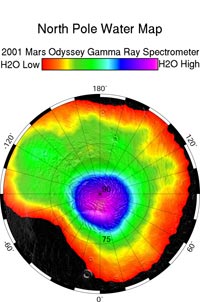The Phoenix spacecraft, launched in August 2007, is landing on Mars this Sunday. It is composed of many different types of components that will help conduct its research on Mars. Some of these instruments are from previous missions that did were abandoned.
One of the major components is the robotic arm. As said in the previous post, the robotic arm will help Phoenix to dig through the topsoil to reach the frozen water underneath. The arm will then bring up the samples up onto the lander for further analysis. This arm also has an attached camera, which allows Phoenix to see what and where it is digging.
There are various types of cameras on board the Phoenix. The Surface Stereo Imager is the primary camera on board, and is also a high resolution stereo camera. The Thermal and Evolved Gas Analyzer will bake and analyze martian dust. The Mars Descent Imager will take pictures of the Martian soil when the lander is descending, starting when the aeroshell is departed, at about 8 km above Mars. Using the Microscopy, Electrochemistry, and Conductivity Analyzer, researchers can examine Martian soil particles as small as 16 micrometers across.
Phoenix also sports a Meteorological Station, with which Phoenix will monitor the daily weather during its entire mission.
The Phoenix DVD is a DVD attached to the Phoenix lander made by The Planetary Society, with Visions of Mars recorded onto it. It is made from special silica glass that will allow it to withstand the conditions of Mars for many years. The DVD contains works from literature and art about Mars, like War of the Worlds by H.G. Wells and messages from Carl Sagan. The Planetary Society also collected names of people in fall of 2006 to place on the front of the disc, about a quarter of million. I myself wasn't one of these people, since I found out about this after the launch of Phoenix. The disc can be comparable to the Voyager Golden Record, which was sent with the Voyager spacecraft.

 Phoenix has made a successful landing on Mars yesterday. Very soon after the landing, it started sending pictures of itself and the area around it. The Phoenix crew (right) is very happy with the results.
Phoenix has made a successful landing on Mars yesterday. Very soon after the landing, it started sending pictures of itself and the area around it. The Phoenix crew (right) is very happy with the results.


 nts, conduct research on the surface of the planet. It will look for environments suitable for microbial life and, in that process, learn more about the history of water on Mars. Since Mars
nts, conduct research on the surface of the planet. It will look for environments suitable for microbial life and, in that process, learn more about the history of water on Mars. Since Mars